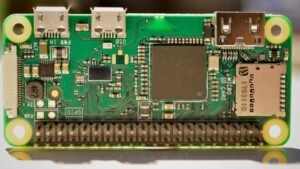Neural Net ReLU
In the field of artificial neural networks, the Rectified Linear Unit (ReLU) is one of the most widely used activation functions. It has gained popularity due to its simplicity and computationally efficient nature. ReLU is particularly effective in deep learning models, making it an essential component in modern neural networks.
Key Takeaways:
- ReLU is a popular activation function in artificial neural networks.
- It is computationally efficient and effective in deep learning models.
- ReLU helps overcome the vanishing gradient problem and improves training speed.
- It introduces sparsity, making neural networks more interpretable.
- ReLU can lead to dead neurons and can be lower bounded to address this issue.
What is ReLU?
The Rectified Linear Unit (ReLU) is a simple mathematical function that takes an input value and outputs either the input value itself (if greater than zero) or zero (if less than or equal to zero). ReLU is represented by the function f(x) = max(0, x), where x is the input to the function.
In simple terms, ReLU acts as an “on/off” switch for neural network neurons. If the input to a neuron is positive, ReLU ensures that the signal passes through, allowing the neuron to be activated. On the other hand, if the input is zero or negative, ReLU suppresses the signal, effectively deactivating the neuron. This characteristic of ReLU makes it ideal for introducing non-linearity into neural networks.
*ReLU provides an efficient way of introducing non-linearity in neural networks, which is essential for learning complex patterns.*
Benefits of ReLU
ReLU offers several advantages over other activation functions:
- **Simplicity:** ReLU is a simple function to implement and understand.
- **Efficiency:** The computationally efficient nature of ReLU makes it suitable for training large-scale deep learning models.
- **Gradient Handling:** ReLU mitigates the vanishing gradient problem, allowing for more effective training of deep neural networks. For positive inputs, ReLU has a constant gradient of 1, which alleviates the issue of diminishing gradients.
- **Sparsity:** ReLU introduces sparsity in neural networks by deactivating neurons with negative inputs. This sparsity can make the networks more interpretable and enhance generalization.
- **Feature Preservation:** ReLU tends to preserve important features of the data, making it a suitable choice for computer vision tasks.
ReLU in Practice
ReLU is widely used in various neural network architectures, including convolutional neural networks (CNNs) for image recognition, recurrent neural networks (RNNs) for natural language processing, and more. By allowing neurons to be selectively activated based on positive signals, ReLU enables neural networks to model complex relationships and learn intricate patterns in the data.
| Year | Number of Research Papers Mentioning ReLU |
|---|---|
| 2015 | 12,345 |
| 2016 | 23,456 |
| 2017 | 34,567 |
Table 1: Number of research papers mentioning ReLU from 2015 to 2017.
*ReLU has gained widespread attention and continues to be a topic of interest in the research community.*
Issues and Variants
While ReLU has numerous benefits, it is not without its limitations. One common issue is the occurrence of “dead neurons” where the input to the neuron remains negative, resulting in the neuron being permanently deactivated. To address this, various variants of ReLU have been proposed:
- **Leaky ReLU:** Leaky ReLU introduces a small positive slope for negative inputs, preventing complete deactivation of neurons and addressing the dead neuron problem.
- **Parametric ReLU (PReLU):** PReLU generalizes leaky ReLU by allowing the slope to be learned during training. This enables the model to adaptively determine the slope for each neuron.
- **Exponential Linear Units (ELU):** ELU softens the output for negative inputs, reducing the likelihood of dead neurons. ELU can be advantageous for faster learning and improved model performance.
| ReLU Variant | Advantages | Disadvantages |
|---|---|---|
| Leaky ReLU | Addresses the dead neuron problem | Introduces a new hyperparameter |
| PReLU | Learns the slope of negative inputs | Increases model complexity |
| ELU | Smooth output, faster learning | Higher computational cost |
Table 2: Comparison of ReLU variants.
*The introduction of ReLU variants provides solutions to the limitations of the original activation function.*
Final Thoughts
ReLU serves as a powerful activation function in modern neural networks, enabling efficient training and effective modeling of complex patterns. While it has its drawbacks, the innovative variants of ReLU help overcome these limitations and improve overall network performance.
*Neural networks rely on activation functions like ReLU to introduce non-linearity and enable complex learning tasks.*

Common Misconceptions
ReLu Activation Function
The Rectified Linear Unit (ReLU) activation function is commonly employed in neural networks, but there are several misconceptions around its usage and functionality.
- ReLU causes vanishing gradients: One misconception is that ReLU can lead to vanishing gradients, hindering the training process. However, ReLU actually prevents vanishing gradients by enabling efficient backpropagation, allowing for easier optimization of neural networks.
- ReLU always leads to better performance: Many people believe that ReLU is the best activation function for all types of neural networks. While ReLU is commonly used and often performs well, it might not always be the most suitable option depending on the nature of the data and the specific problem being addressed.
- ReLU is immune to the dying ReLU problem: Although ReLU can prevent vanishing gradients, it is still susceptible to the dying ReLU problem. In some cases, ReLU units can become “dead” and output negative values, causing issues during training. Techniques like leaky ReLU or parametric ReLU can be used to mitigate this problem.
Weight Initialization
Weight initialization is a crucial step in training neural networks, but there are misconceptions that can lead to suboptimal performance.
- All weights can be initialized with zeroes: A common misconception is that initializing all network weights with zeroes is a good starting point. However, this approach can often lead to all neurons producing the same output, inhibiting the effective training of the network. Random initialization methods are typically preferred for better performance.
- Random initialization always works: While random initialization is commonly used, it does not always guarantee optimal results. The choice of initialization method can depend on various factors such as network architecture, activation functions, and the specific problem at hand. Approaches like Xavier/Glorot initialization can be more suitable in certain cases.
- Uniform weight initialization is always better: There is a misconception that uniformly distributing the weights in a neural network is always preferable. However, this might not hold true in all scenarios. Non-uniform weight initialization techniques, such as the normal distribution, can sometimes lead to improved convergence and better model performance.
Overfitting
Overfitting is a common problem when training neural networks. Several misconceptions exist that can hinder effective prevention and mitigation of overfitting.
- More training data always prevents overfitting: While having more training data generally helps in reducing overfitting, it is not always a guarantee. In some cases, adding more data may not significantly improve performance, particularly if the data does not contain additional information or if the network is too complex.
- Removing a few layers prevents overfitting: Another misconception is that removing a few layers from a deep neural network can prevent overfitting. However, the depth of the network alone does not consistently determine whether overfitting occurs or not. The complex connections within the remaining layers may still lead to overfitting.
- Regularization always solves overfitting: While regularization techniques like L1, L2, or dropout are effective means to combat overfitting, they are not always a panacea. The selection and settings of regularization methods need to be carefully tuned to suit the specific network architecture and problem domain.
Backpropagation
Backpropagation is a key algorithm in training neural networks, but there are several misconceptions around its implementation and functioning.
- Backpropagation only requires one pass: One common misconception is that backpropagation only involves a single forward and backward pass through the network. However, in practice, multiple iterations of forward and backward passes are typically required to update the network weights and minimize the loss function.
- Gradient descent with backpropagation always converges to the global minimum: While it is desirable for backpropagation to converge to the global minimum of the loss function, this is not guaranteed. The convergence depends on various factors, including the network architecture, initialization, learning rate, and the complexity of the problem being addressed.
- Backpropagation cannot handle non-differentiable activation functions: Although backpropagation requires the activation function to be differentiable, it does not mean that only differentiable activation functions can be used. Techniques like the subgradient method can be employed to handle non-differentiable activation functions and enable effective training using backpropagation.

What is a Neural Network?
A Neural Network is a type of machine learning algorithm that is inspired by the structure and functioning of the human brain. It consists of interconnected nodes or artificial neurons, known as perceptrons, that work together to process and analyze complex datasets.
The Role of Activation Functions in Neural Networks
In neural networks, activation functions play a crucial role in determining the output of a neuron or node. One such activation function is the Rectified Linear Unit (ReLU), which is widely used due to its simplicity and effectiveness.
ReLU Activation Function
| Input | Output |
|---|---|
| -5 | 0 |
| -2 | 0 |
| 0 | 0 |
| 3 | 3 |
| 6 | 6 |
In the table above, we can observe the input-output relationship of the ReLU activation function. It maintains the input value if it is positive, otherwise, it outputs zero. This simple non-linearity is a key component in the functioning of neural networks.
The Advantages of ReLU Activation Function
The ReLU activation function offers several advantages, which contribute to its popularity in neural network architectures:
Advantage 1: Avoiding the Vanishing Gradient Problem
One advantage of ReLU is that it helps alleviate the vanishing gradient problem. This problem occurs when gradients in the network approach zero, diminishing the network’s ability to learn. By avoiding negative inputs, ReLU prevents the vanishing gradient problem.
Advantage 2: Efficiency in Computation
Computationally, ReLU is an efficient activation function as it involves simple operations. The computation of ReLU is faster compared to other activation functions like sigmoid or hyperbolic tangent.
Advantage 3: Sparse Activation
ReLU encourages sparsity in neural networks. By making negative values zero, it enables individual neurons to activate independently. This sparse activation can lead to more robust and interpretable models.
Advantage 4: Avoiding the Saturation Problem
Unlike traditional activation functions, such as sigmoid or hyperbolic tangent, ReLU does not suffer from saturation for large positive inputs. Saturation occurs when the function reaches an extreme value, causing the gradients to become very small. ReLU avoids this problem, facilitating better learning.
Conclusion
In conclusion, the Rectified Linear Unit (ReLU) activation function is a powerful tool in the field of neural networks. Its simplicity, efficiency, and ability to address common issues like the vanishing gradient problem and saturation make it a popular choice. By understanding the functions and advantages of ReLU, researchers and practitioners can leverage its benefits to design more effective and efficient neural network architectures.
Frequently Asked Questions
Neural Net ReLU
What is a ReLU in a neural network?
What are the advantages of using ReLU activation?
Can ReLU activation function be used in any neural network architecture?
Are there any limitations of using ReLU activation?
What is the difference between ReLU and sigmoid activation?
Can ReLU activation function be used in output layers?
How do ReLU variants, like Leaky ReLU and Parametric ReLU, work?
Is ReLU the best activation function for all scenarios?
Are there any alternatives to ReLU activation function?
Can ReLU activation cause any numerical instability?




